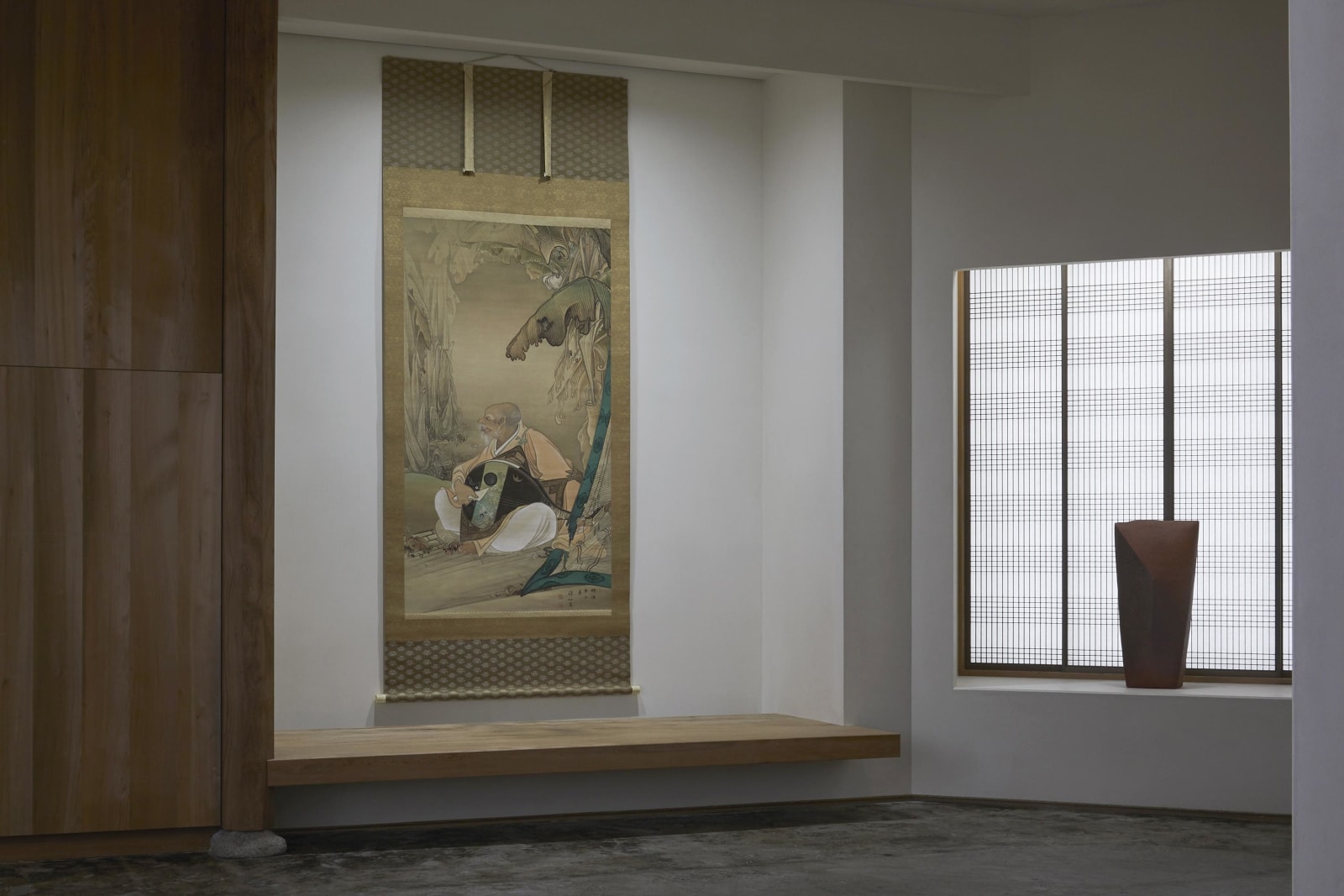Tomita Keisen (1879–1936)
Recluse
Color, gold, and silver on silk, hanging scroll
1900
With a Tokyo Art Club certificate
Seals: Tomita no sho, Keisen
153.3 x 85.4 cm
249 x 101 cm (overall)
1900
With a Tokyo Art Club certificate
Seals: Tomita no sho, Keisen
153.3 x 85.4 cm
249 x 101 cm (overall)
Further images
Provenance
Collection of Kawarada HeisukeExhibitions
Kyoto Bijutsu Kyokai jisshunen kaiko-ten. Kyoto: Nanzen-ji Temple, 1900.Tomita Keisen isaku-ten. Fukuoka: Tamaya, 1943.
Literature
Keisen iboku-shu. Kyoto: Unsodo, 1937.
This is a scene of a recluse playing biwa, or a Japanese lute, and humming an ode. The lute is decorated with eulalia grass, maiden flowers, bush clover and Chinese bellflowers along with the full moon, typifying the beauty of autumn. Yet with the banana leaves withering behind, and the broken curtain leaning aside, the air is enveloped in a deep austerity, passing on a sense of loneliness. The seasons elapse one after another; even the glorious autumn scenery would fall into decay, which mirrors the ephemerality of time.
Tomita Keisen, aspired to become a painter, left his hometown Hakata for Kyoto at eighteen. Apprenticed under Tsuji Kako, Keisen excelled at Shijo school; he was also an enthusiast keen on experimenting the Western-style paintings; and to enrich his knowledge of antiquities, he visited Kennin-ji, Horyu-ji, and many other temples to conduct treasure-sketching. This work was perhaps inspired by Moso-biwa, or the blind priest’s lute performance, and was awarded the first prize at the tenth anniversary retrospective of the Kyoto Art Association, held at Nanzen-ji Temple from May 21 to 25, 1900. Prior to the well-known A Child (1901) in the Fukuoka Art Museum and Cherry Blossoms and Cat (1905) in the Museum of Modern Art, Shiga, it is arguably a painting of importance to reveal the early style of Keisen.
There exist two schools of Moso-biwa today, the Chikzuen-moso in Joju-in Temple in Fukuoka and the Satsuma-moso of Joraku-in Temple in Kagoshima, both of whose tradition have been passing down through centuries. After being away from Kyushu for four years, Keisen, by choosing this motif, expresses his nostalgia and affection for his hometown in this masterpiece.
Tomita Keisen (nihonga painter; 1879–1936)
Fukuoka-born nihonga painter. His real name is Shigegoro. Learned Shijo school style under Tsuji Kako. Later admired Tomioka Tessai and Sengai Gibon. Studied Buddhist paintings from the Nara and Heian periods. Executed a number of portraits, landscapes, and Buddhist paintings. Active as a member of Nihon Bijutsuin (Japan Art Institute).
Tomita Keisen, aspired to become a painter, left his hometown Hakata for Kyoto at eighteen. Apprenticed under Tsuji Kako, Keisen excelled at Shijo school; he was also an enthusiast keen on experimenting the Western-style paintings; and to enrich his knowledge of antiquities, he visited Kennin-ji, Horyu-ji, and many other temples to conduct treasure-sketching. This work was perhaps inspired by Moso-biwa, or the blind priest’s lute performance, and was awarded the first prize at the tenth anniversary retrospective of the Kyoto Art Association, held at Nanzen-ji Temple from May 21 to 25, 1900. Prior to the well-known A Child (1901) in the Fukuoka Art Museum and Cherry Blossoms and Cat (1905) in the Museum of Modern Art, Shiga, it is arguably a painting of importance to reveal the early style of Keisen.
There exist two schools of Moso-biwa today, the Chikzuen-moso in Joju-in Temple in Fukuoka and the Satsuma-moso of Joraku-in Temple in Kagoshima, both of whose tradition have been passing down through centuries. After being away from Kyushu for four years, Keisen, by choosing this motif, expresses his nostalgia and affection for his hometown in this masterpiece.
Tomita Keisen (nihonga painter; 1879–1936)
Fukuoka-born nihonga painter. His real name is Shigegoro. Learned Shijo school style under Tsuji Kako. Later admired Tomioka Tessai and Sengai Gibon. Studied Buddhist paintings from the Nara and Heian periods. Executed a number of portraits, landscapes, and Buddhist paintings. Active as a member of Nihon Bijutsuin (Japan Art Institute).





